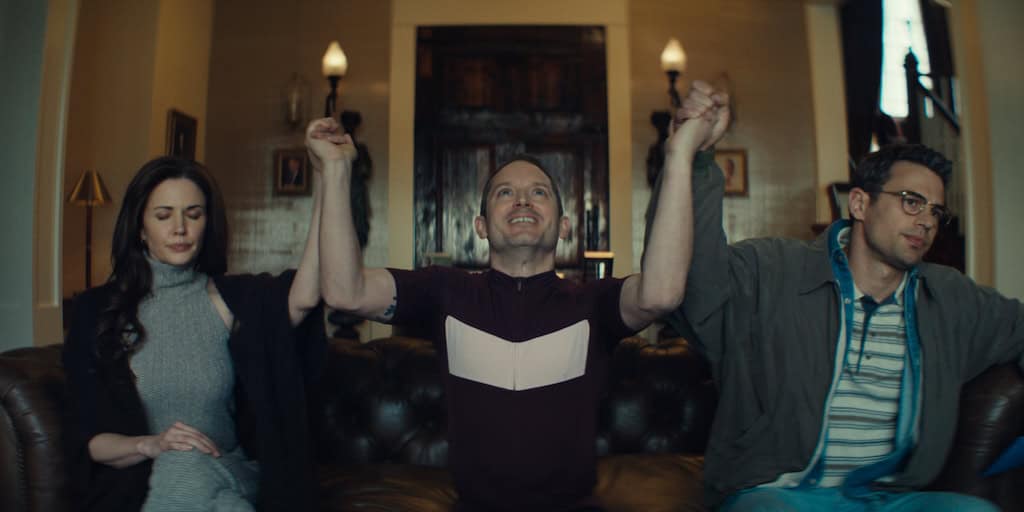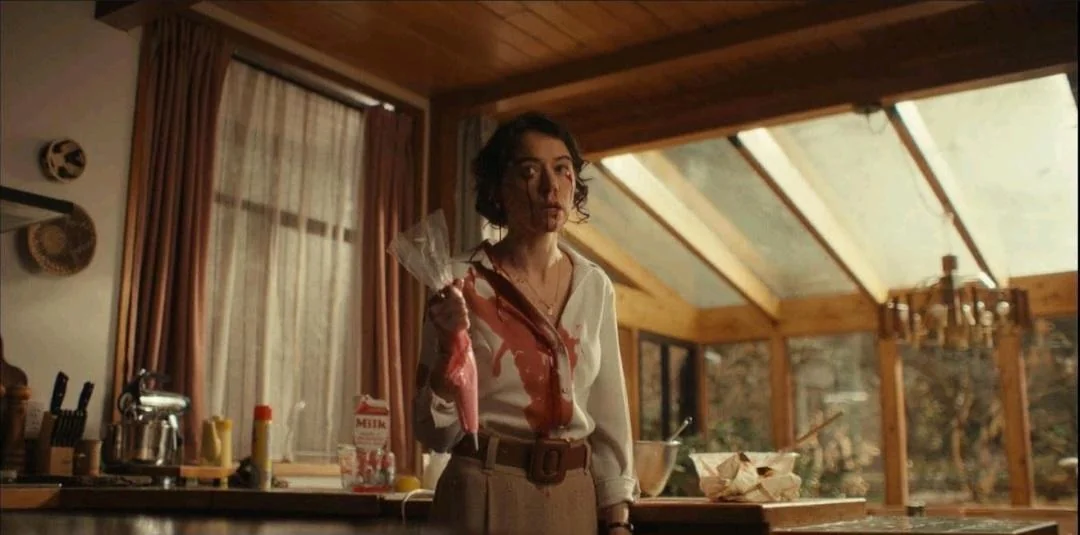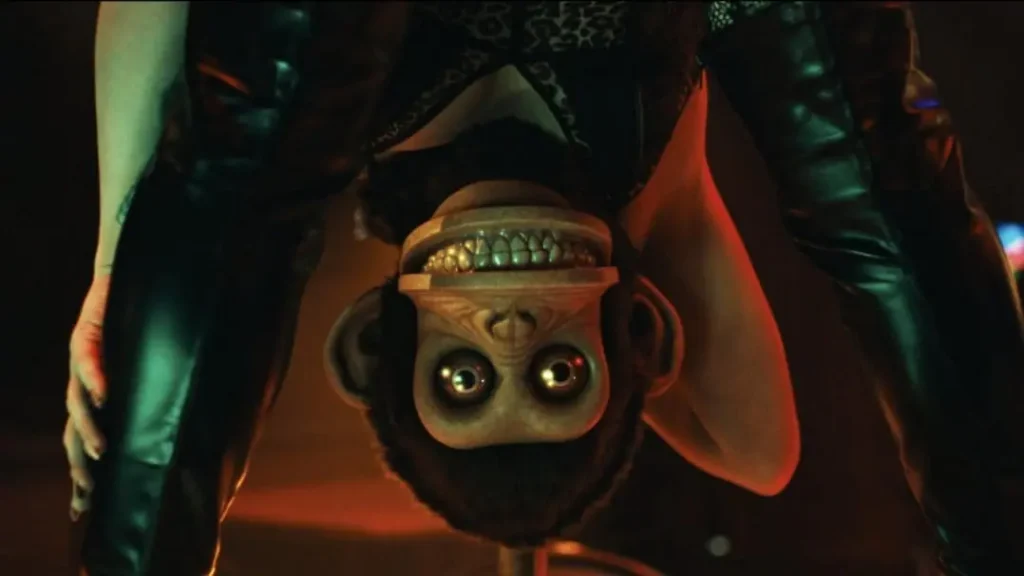
There’s a certain weight that comes with finding the past boxed up in an attic — heavier still when it clangs like cymbals and grins without reason. In The Monkey, twin brothers Hal and Bill stumble across a childhood toy owned by their father who disappeared and never came back: a garish, wind-up monkey whose percussive hands are less nostalgic and more fatal. What follows is not a simple haunting, but a slow unraveling — of lives, of memory, and of the type of trauma that skips generations, coated with irony and a dash of twisted humor.
When people around the brothers begin to die with eerie timing to the monkey’s clatter, they realize what they once buried — both figuratively and literally — has clawed its way back up. Time folds: from the present to the unsettling recesses of childhood, where the line between plaything and harbinger was always blurred. The horror here isn’t purely supernatural — it’s entangled with satire, dysfunctional family dynamics, and a comedic streak that sneaks in through the cracks.
Osgood Perkins doesn’t just adapt a Stephen King short story — he dissects it with a sly grin, folds it inside-out, and stitches it together with his own morbid fascinations. The Monkey isn’t interested in cheap scares or dusty nostalgia. It’s laced with sarcasm and stylized dread, as if grief and guilt wore clown paint and cracked smiles. It asks, what if trauma came with a wind-up key? What if family curses played out like a cruel inside joke?
When I first heard The Monkey was directed by Osgood Perkins — the same mind behind Longlegs — I was genuinely intrigued. Longlegs left a mark, and Perkins has a distinct directorial voice that piques curiosity. Add to that the Stephen King factor, and you’d think I’d be sold. But here’s the twist: I’m also a die-hard Stephen King fan — the kind who’s read the short stories, the novels, and the weird in-between experiments. And that made me skeptical. Why? Because if there’s one thing King adaptations struggle with, it’s turning short stories into full-length films. They rarely translate well — not on screen, and let’s be honest, sometimes not even on the page. So, while half of me was thrilled about the director, the other half expected a mess. And yeah… that second half was mostly right.

Did I hate The Monkey? No. Did I love it? Also no. Was I bored? Definitely not. But did I enjoy it? That’s a harder question. The film is well-crafted in certain areas — the editing is sharp, the production design textured, and the cinematography often does the heavy lifting. These are undeniable strengths. But then there’s the story. And… well, that’s where it all wobbles. I’ve never been a fan of the original short story to begin with, and the film didn’t do much to change my mind. It suffers from a clear identity crisis: part black comedy, part gore-fest, part dysfunctional family drama, part YA horror with glossy aesthetics. At times, it feels like it’s aiming to be a more elegant version of Final Destination — but because it half-commits, it ends up falling short. And if we’re being honest, Final Destination still wins despite artistically The Monkey is better because at least Final Destination knows what it is, and simply because—if you allow me—when you half-ass everything, you never really land a full-ass experience.
If there’s one thing The Monkey lands, it’s accidental humor — or maybe it’s intentional. Either way, you’ll probably laugh a few times. Maybe even flinch once or twice. Perkins does have a knack for building tension and staging inventive kill scenes. The movie is smartly orchestrated in those moments, and you can’t deny the directorial control. But still, the performances? Outside of the mother, most felt mechanical, even robotic — and not in a naturalistic way. It’s hard to tell if that stiffness was by design, part of some satirical edge, or just awkward execution. With so many jumps between timelines and tones, the characters never have space to breathe. You observe them, but never connect. You witness their arcs, but don’t feel their journey. And that emotional distance makes the entire experience feel… detached.
This isn’t horror built for screaming — it’s more of a slow, ironic ache. A kind of haunted theater where everything plays out just a little too absurdly to be real, yet never quite campy enough to be fun. Perkins blends the supernatural with a cold, Midwestern routine where the dead don’t merely linger — they do dishes, babysit, and crash dinner. The terror is domestic, but the tone walks a tightrope between eerie and ironic.

At the end of the day, Osgood Perkins is both the film’s biggest asset and its greatest complication. All the things that work — the visual atmosphere, the stylized kills, the strange yet confident pacing — they’re tied to his vision. But so are the things that don’t. The film’s fragmented structure, its narrative dissonance, its hollow character arcs, and even the eerie, off-kilter performances — they all feel like conscious decisions. Maybe it’s meant to be ironic or a meta-commentary on the horror genre. But intention doesn’t always equal connection. Sometimes, you can admire the craft and still feel nothing. The Monkey is filled with deliberate choices. They just don’t always lead anywhere.
So, where does that leave us? In a liminal space between “impressive” and “forgettable.” The Monkey is never boring. It’s beautifully shot, expertly edited, and clearly helmed by someone with vision. But it’s also emotionally distant, narratively uneven, and tonally conflicted. You might laugh a few times. You might flinch once or twice. And you’ll probably admire Perkins for trying something bold. But when the credits roll, you’re left with a film that half-commits to too many things — and that rarely results in a full experience.
Rating (5.5/10): ★ ★ ★ ★ ★ ½ ☆ ☆ ☆ ☆
